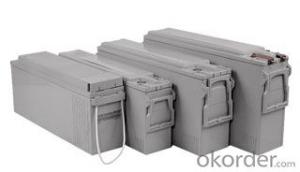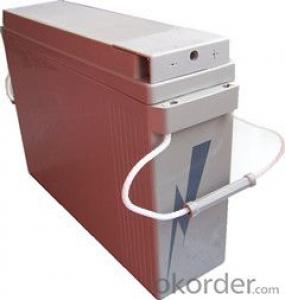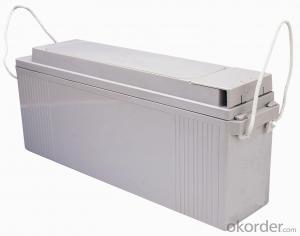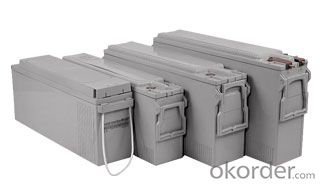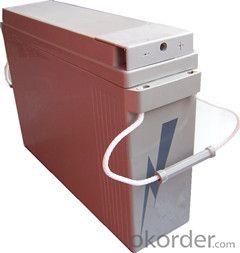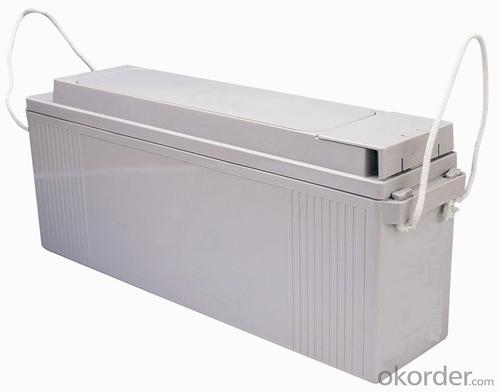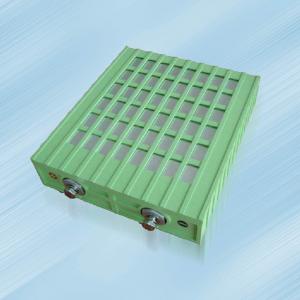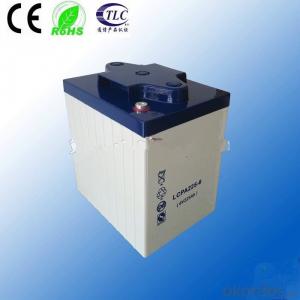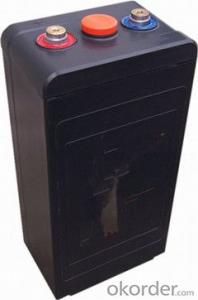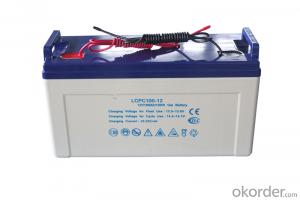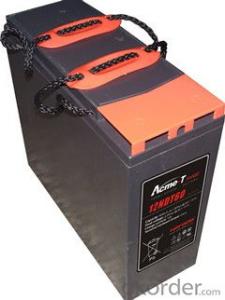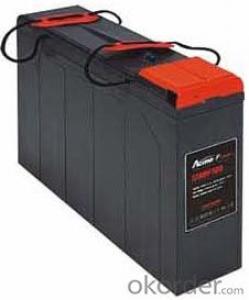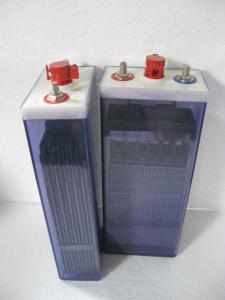Gel Battery MPG Series Battery MPG12V90F
- Loading Port:
- Shanghai
- Payment Terms:
- TT OR LC
- Min Order Qty:
- 1000 unit
- Supply Capability:
- 500000 unit/month
OKorder Service Pledge
OKorder Financial Service
You Might Also Like
Gel Battery MPG Series Introduction
The MPG range gel batteries are designed with front terminal structure. The perfect design ensures MPG series battery the high reliability and makes the installation quite simple and safe when placed on a standard relay rack tray or in a closed cabinet. Adopt Flat plates with gel electrolyte.
This new technology leverages on the advantages of the AGM and Ares technology to provide better cycle performance versus the AGM technology and a shorter time discharge performance as compared with the Gel technology.
MPG range gel battery is designed with high energy density and suitable for 19", 23" rack or cabinet, and also offers options of top connection and side of monoblocs connection. MPG range battery can be equipped with central gas collection system according to the requirement of customer.
The MPG batteries are ensured the quality with the ISO9001 standard.

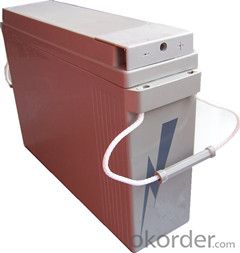
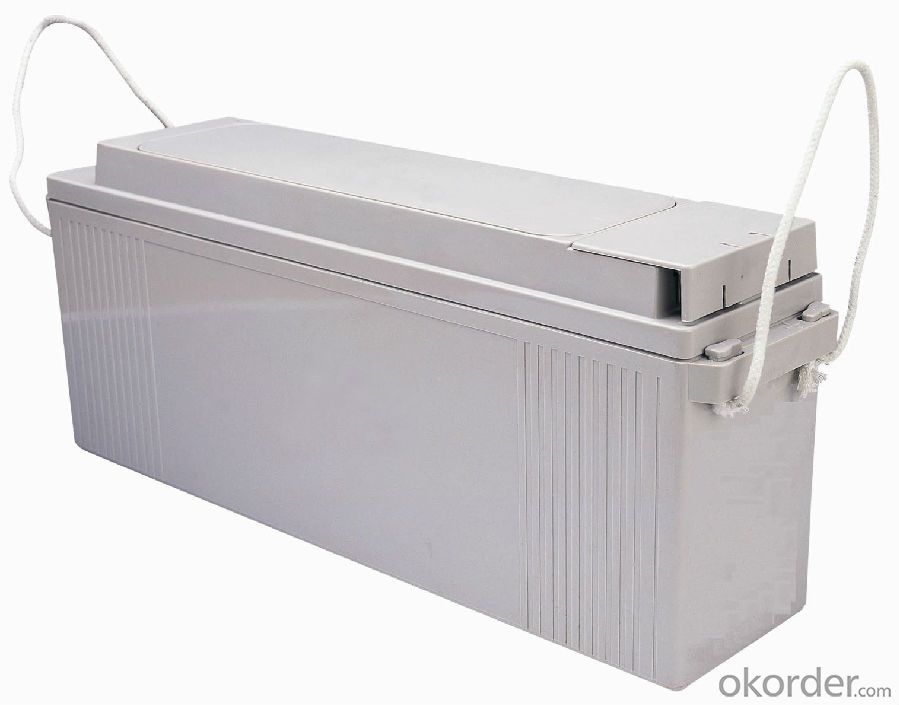
Gel Battery MPG Series Technical Feature:
Gel technology applied in MPG range batteries.
Front-access terminal connections for fast and easy installation and maintenance
Suitable for 19", 23" rack or cabinet
Excellent special lead-tin-calcium formula alloy for Grids and plates
Mircoporous glass mats in low resistance as separator
Self-regulating pressure relief valve
12+ years expectant Life under full float service at 25oC(77oF)
Type: | MPG12V90F | |
Voltage: | 12V | |
Nominal Capacity: | 85Ah(C10) | 85Ah(10 hours rate:) |
Length: | 395mm | |
Width: | 105mm | |
Height: | 270mm | |
Height with termial: | 270mm | |
Weight: | 28Kg |
Gel Battery MPG Series Compliant Standards :
IEC60896-21/22
Din standard
UL
Manufactured under system ISO9001(TUV)
Gel Battery MPG Series Battery Installation Compliant with:
EN 50272-2 or local equivalents
Gel Battery MPG Series Main Application:
Telecommunications
Uninterruptible power supply (UPS)
Switchgear / utility
Other applications to provide integrated stored energy system
Gel Battery MPG Series Products Characteristics:
Recommended float charge voltage for 12V battery:
2.25Vpc at 25oC(77oF)
Self discharge rate: < 2% per month at 25oC(77oF)
Shelf life: six months at 25oC(77oF)
Valve regulated system, no water addition needed.
FAQ
![]() What is sulfation of batteries?
What is sulfation of batteries?
Sulfation is the formation or deposit of lead sulfate on the surface and in the pores of the active material of the batteries' lead plates. If the sulfation becomes excessive and forms large crystals on the plates, the battery will not operate efficiently and may not work at all. Common causes of battery sulfation are standing a long time in a discharged condition, operating at excessive temperatures, and prolonged under or over charging.
![]() How long a battery can last?
How long a battery can last?
The service design life of a battery are vary considerably with how it is used, how it is maintained and charged, temperature, and other factors.
![]() Do batteries self-discharge when not in use?
Do batteries self-discharge when not in use?
All batteries, regardless of their chemistry, self-discharge. The rate of self-discharge depends both on the type of battery and the storage temperature the batteries are exposed to. However, for a good estimate, Narada batteries self-discharge approximately 4% per week at 80ĄăF.
![]() How can I evaluate the health and charge state of a battery?
How can I evaluate the health and charge state of a battery?
Routine battery examinations divulge irregularities in the charging system as well as in the batteries. The principle method is to examine the electrochemistry of the battery through hydrometric electrolyte inspection. As previously discussed, this important examination cannot be accomplished with sealed absorption or gel batteries. Voltage readings alone require experience to interpret. Hydrometric readings will uncover early warnings of overcharging or overdischarging before batteries are damaged. The state-of-charge and reliability of a lead acid battery can best be determined by the specific gravity of the electrolyte measured directly with a common bulb-type hydrometer with a glass float. We do not recommend the ball float type hydrometer. Specific gravity is a unit of measurement for determining the sulfuric acid content of the electrolyte. The recommended fully charged specific gravity of marine batteries is 1.255 to 1.265 taken at 80ĄăC More than .025 spread in readings between fully charged cells indicates that the battery may need an equalization charge. If this condition persists, the cell is failing and the battery should be replaced. Since water has a value of 1.000, electrolyte with a specific gravity of 1.260 means it is 1.260 times heavier than pure water while pure concentrated sulfuric acid has a specific gravity of 1.835.
- Q: What is the difference between a maintenance-free battery and a conventional battery?
- Lead-acid battery is composed of positive and negative plates, partitions, shell, electrolyte and wiring pile head and other components, the discharge of the chemical reaction is to rely on positive electrode active substances (lead dioxide and lead) and negative plate active substances (sponge Pure lead) in the electrolyte (dilute sulfuric acid solution) under the action, which plate grid, the traditional battery lead and antimony alloy manufacturing, maintenance-free battery is made of lead calcium alloy, the former with antimony, the latter with calcium, This is the fundamental difference between the two points.
- Q: What are the technical parameters of the battery?
- Battery capacity is defined as ∫ t0tdt, theoretically t can be infinite, but in fact when the battery discharge is lower than the termination voltage continues to discharge, which may damage the battery, so t value is limited, the battery industry, in hours (h) Battery sustainable discharge time, feel the C24, C20, C10, C8, C3, C1 and other nominal capacity value.
- Q: How to determine the battery is good or bad?
- Instrument test: the general use of battery discharge tester, the test instrument two positive and negative clamp were holding the battery positive and negative electrodes, press the test button to observe the test instrument instructions.
- Q: How to deal with waste batteries?
- Laboratory recycling method: ordinary dry battery is cylindrical, the outer cylinder made of zinc, the zinc cylinder is the battery negative; tube central carbon rod for the positive; tube for the manganese dioxide, ammonium chloride and chlorination Zinc.
- Q: What battery does the van use?
- The battery is mainly composed of tube positive plate, negative plate, electrolyte, separator, battery compartment, battery cover, pole, injection liquid cover and so on. The electrode of the exhaust type battery is made of lead and lead oxide, and the electrolyte is an aqueous solution of sulfuric acid. The main advantage is the voltage stability, the price is cheap; the disadvantage is lower than the energy (that is, per kilogram of battery storage power), short life and routine maintenance frequently. Old ordinary battery life of about 2 years, and the need to regularly check the height of the electrolyte and add distilled water. However, with the development of science and technology, lead-acid battery life becomes longer and maintenance is also more simple.
- Q: How should the battery be well maintained?
- So the proposed owners if the vehicle long-term stop, but also 2 to 3 months for the battery for a charge.
- Q: 80ah how much battery storage capacity?
- Is 80AH. Understood to discharge at 80 amps for about 1 hour (but not to say that after 1 hour is finished, there is still electricity). In theory, this is your battery power.
- Q: What is a maintenanceable battery?
- Maintenance-free battery due to its own structure on the advantages of electrolyte consumption is very small, in the life of the basic need not add distilled water.
- Q: Battery 200ah / 104 what does that mean?
- 2V battery capacity (from 200AH-3000AH have) long design, good stability, the price is also expensive; 12V battery capacity is generally the largest 250AH, design life as 2V, price economy, high current discharge better.
- Q: Lead-acid battery how to maintain?
- After passing the test, cover the exhaust cutting, pay attention to restore the filler, cover the battery cover, if the cover is glued, then glue bonding.
Send your message to us
Gel Battery MPG Series Battery MPG12V90F
- Loading Port:
- Shanghai
- Payment Terms:
- TT OR LC
- Min Order Qty:
- 1000 unit
- Supply Capability:
- 500000 unit/month
OKorder Service Pledge
OKorder Financial Service
Similar products
Hot products
Hot Searches
Related keywords
